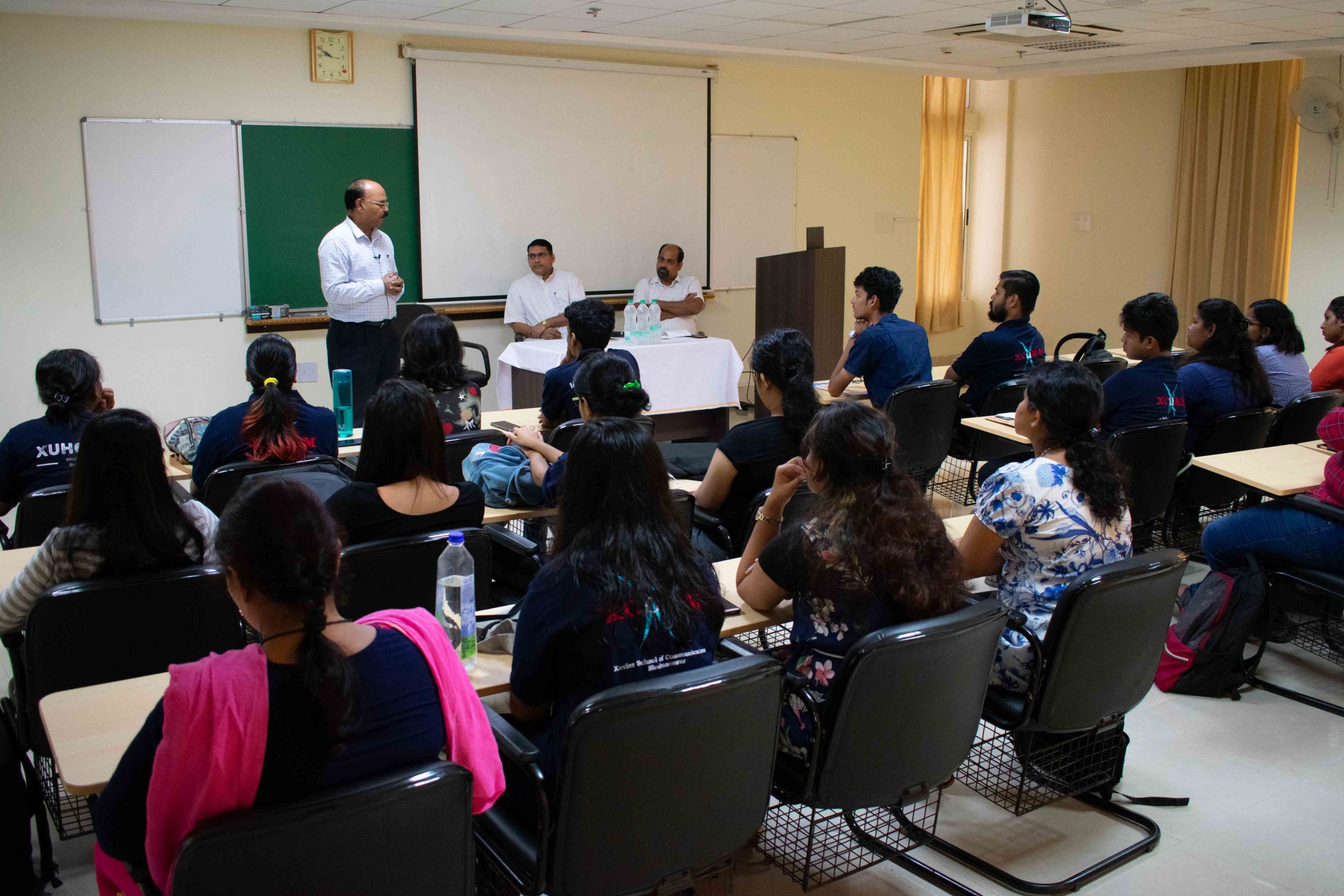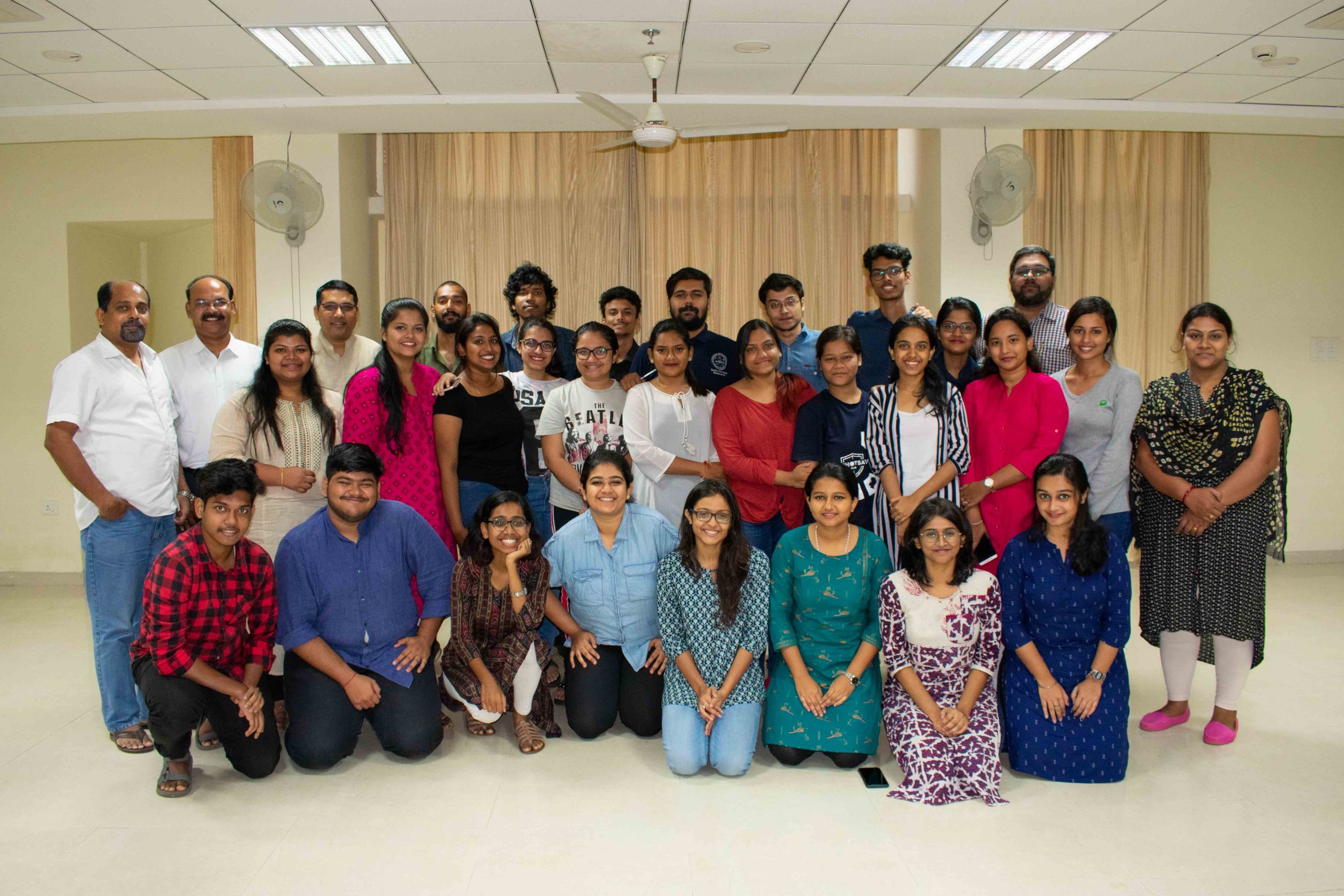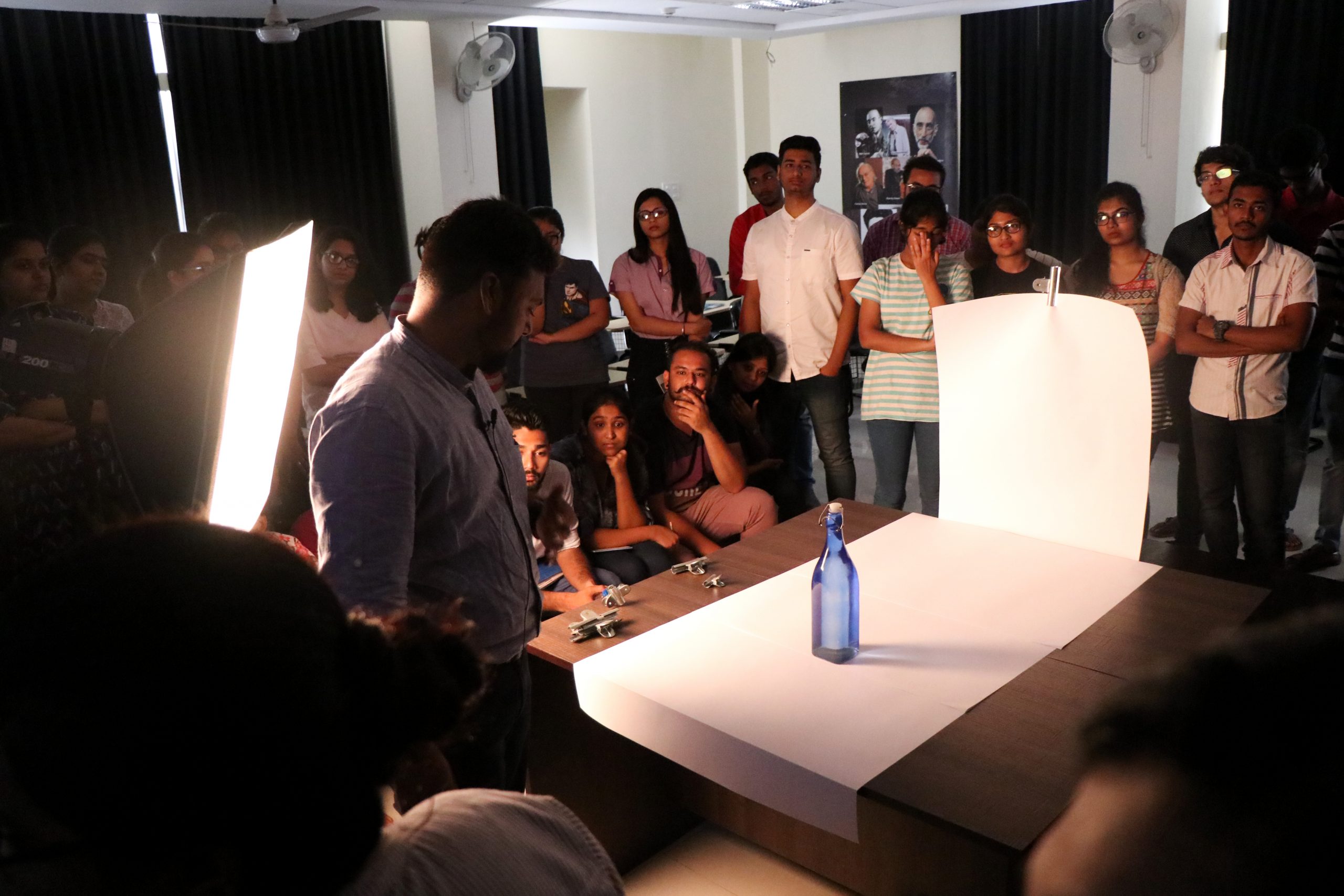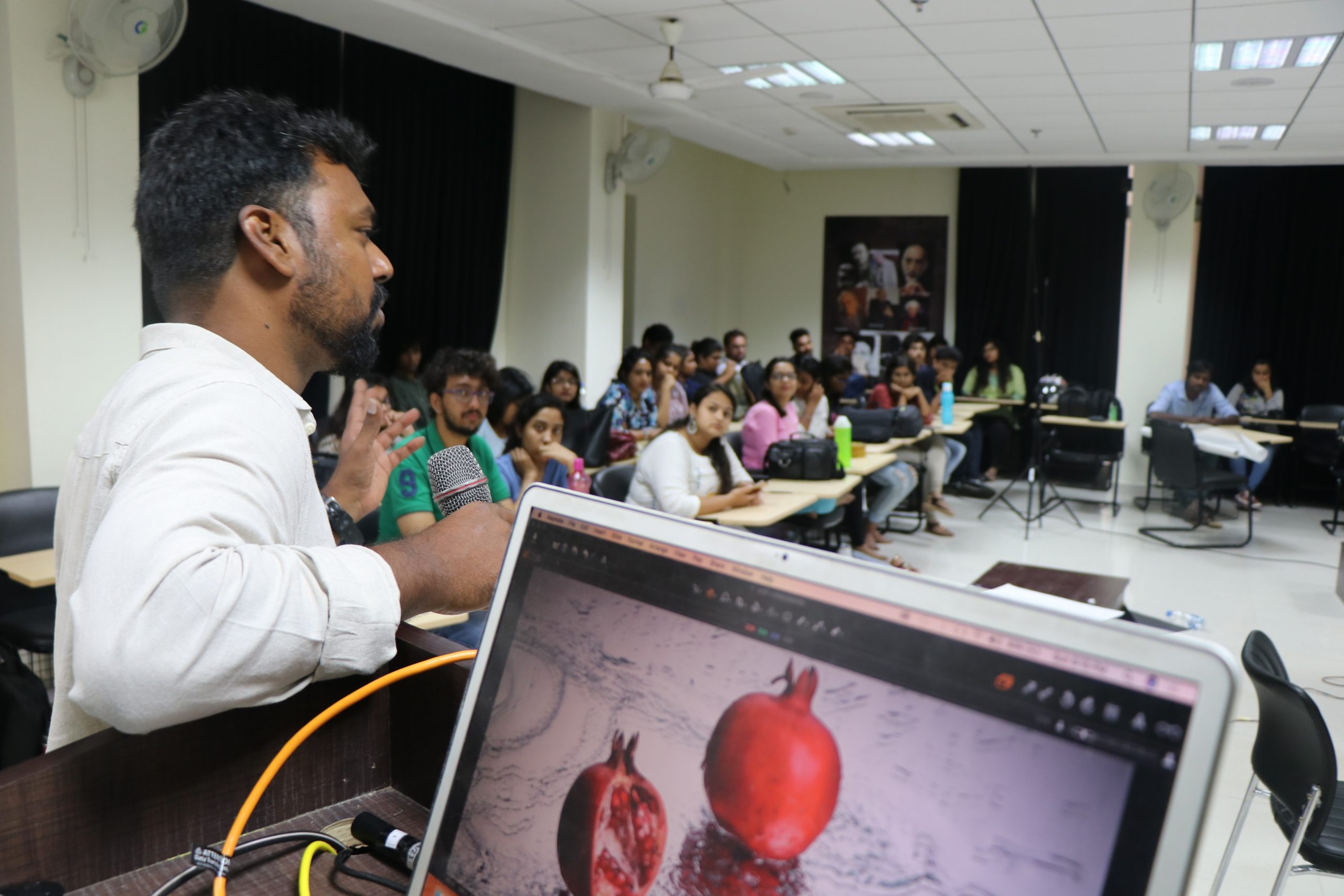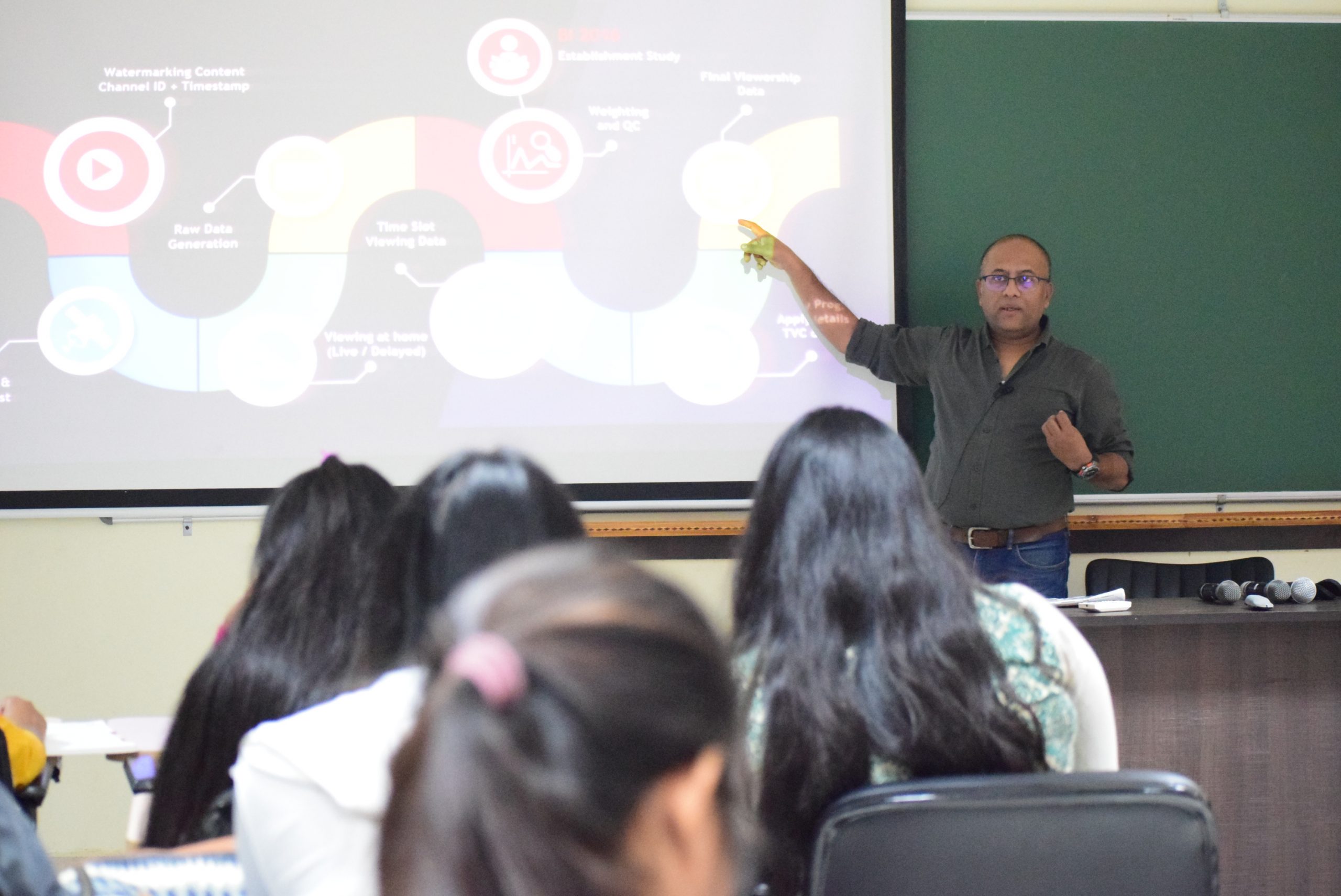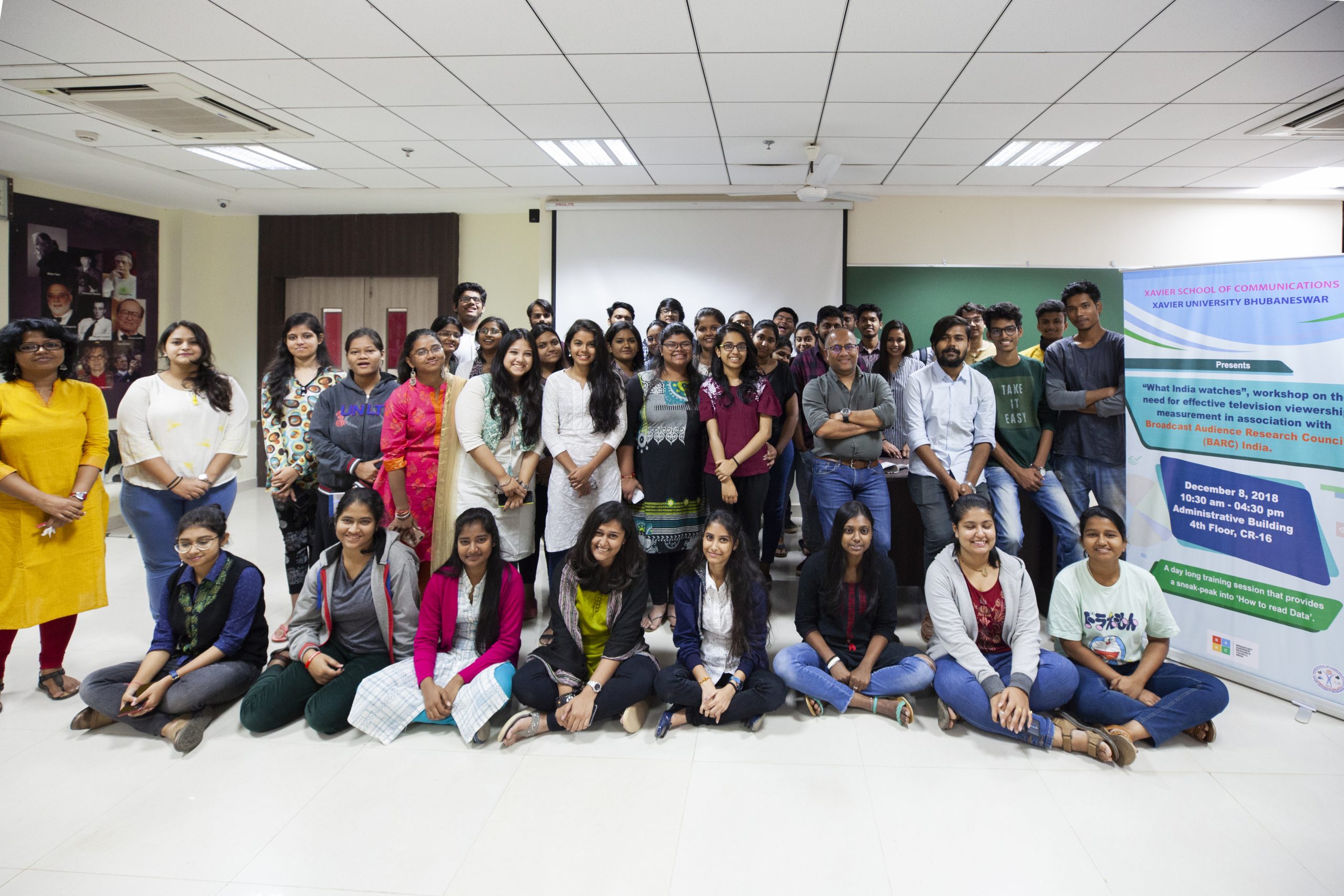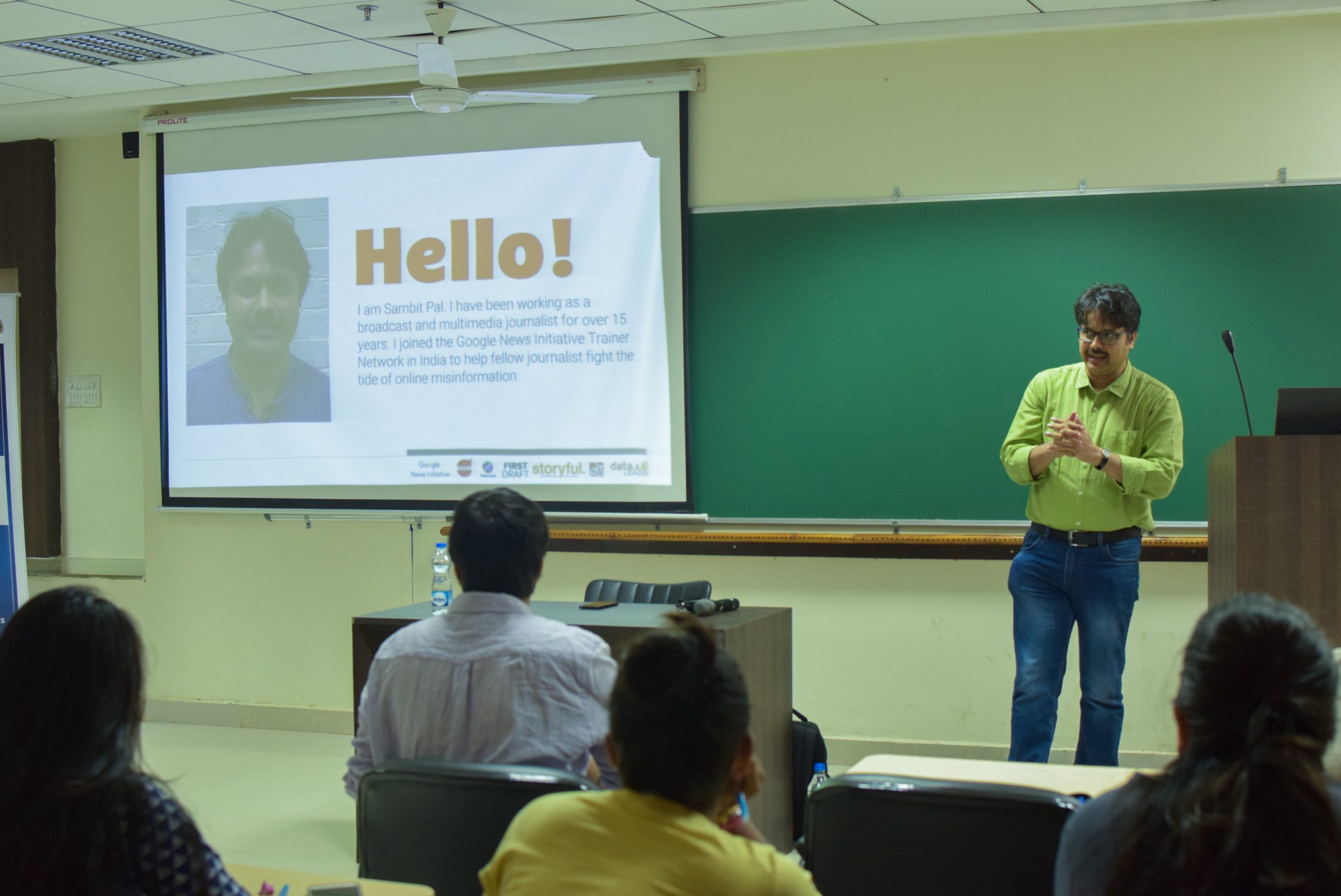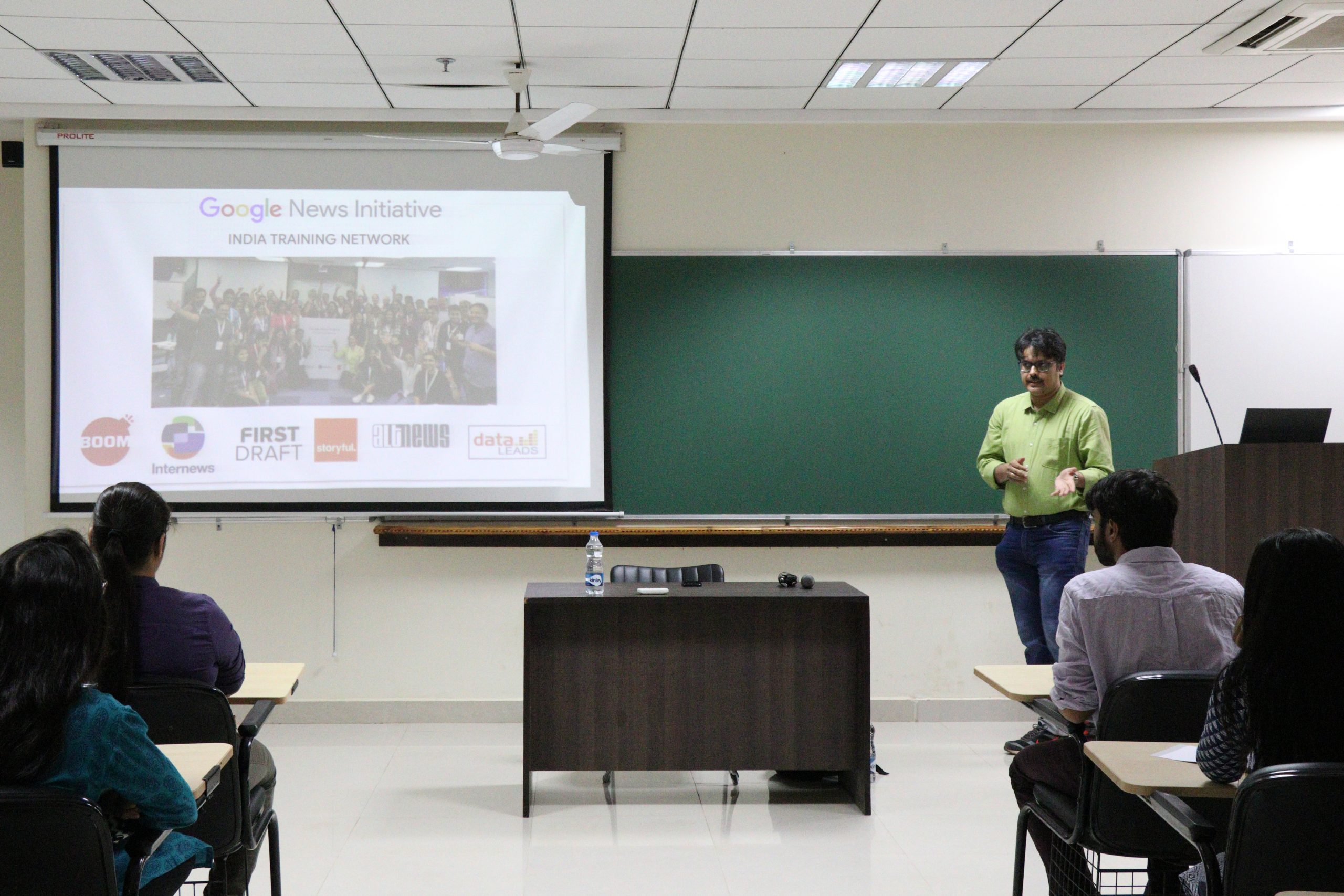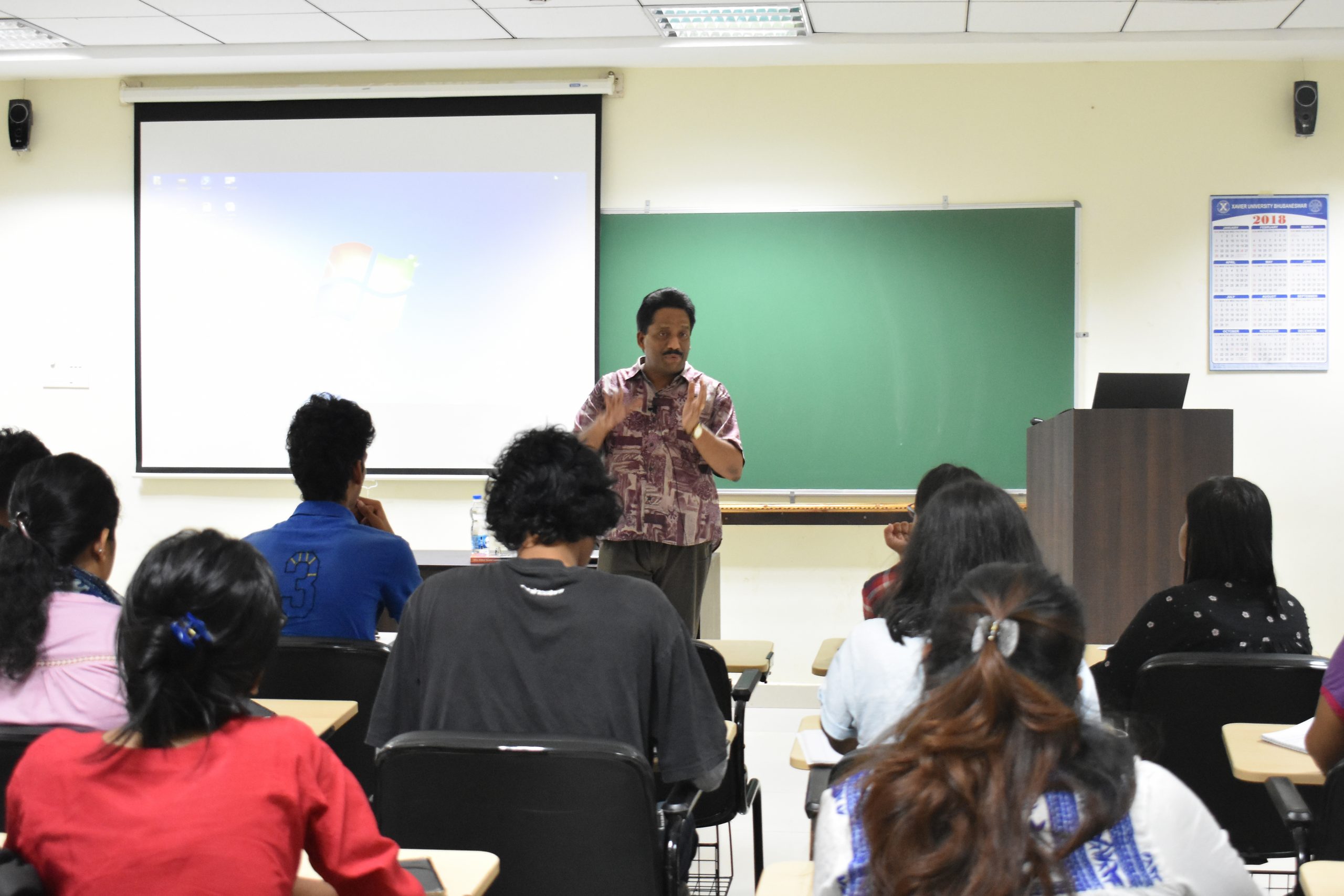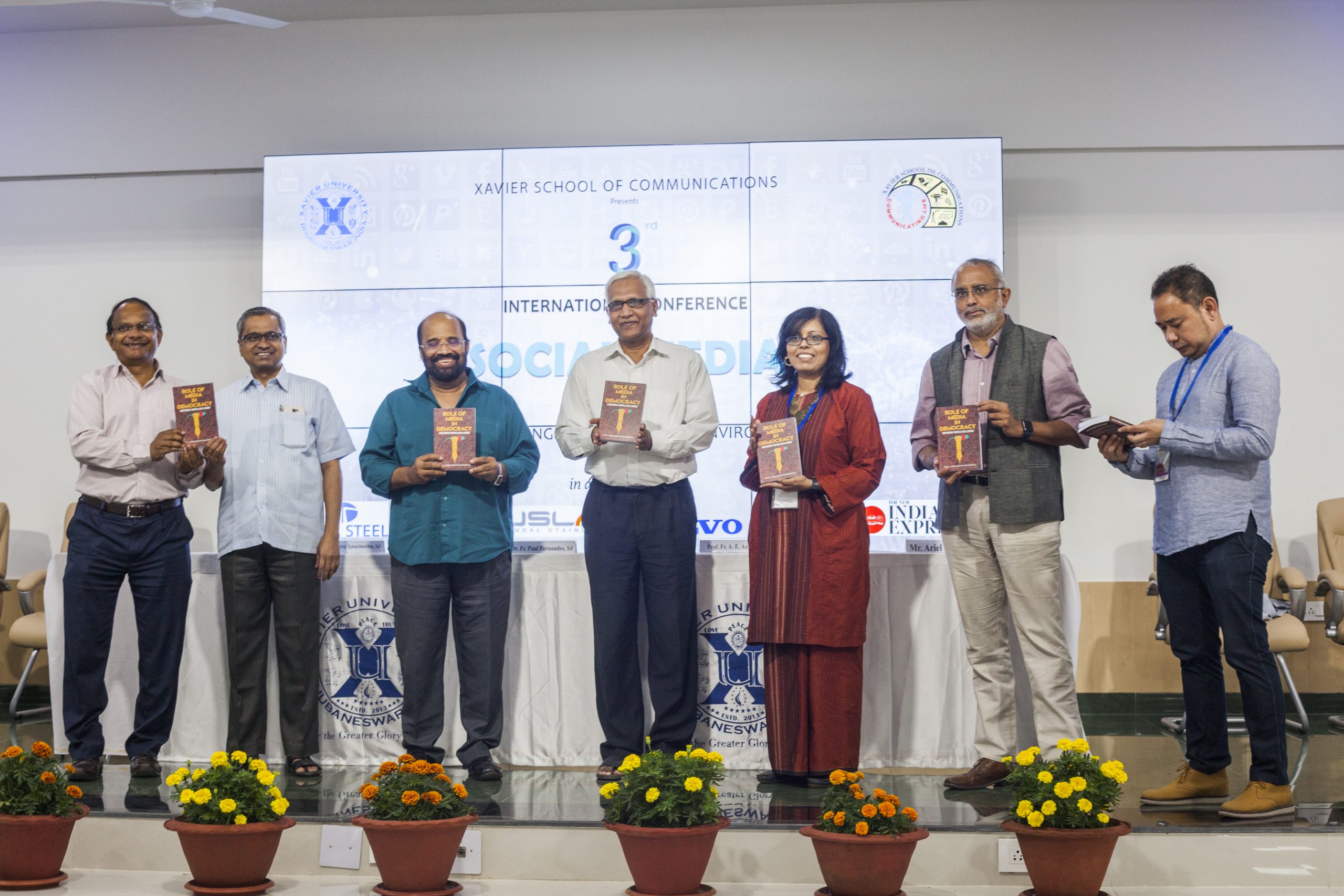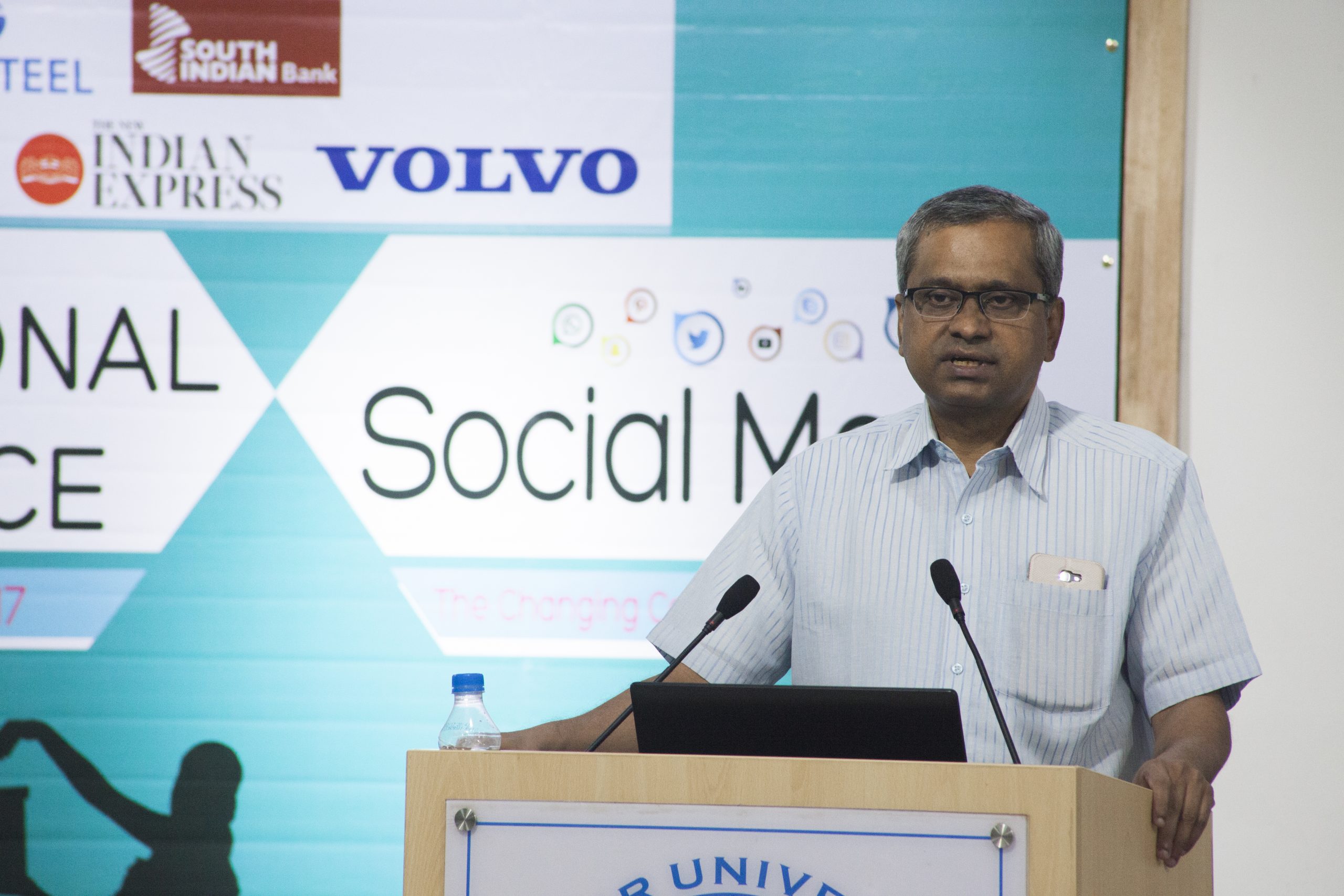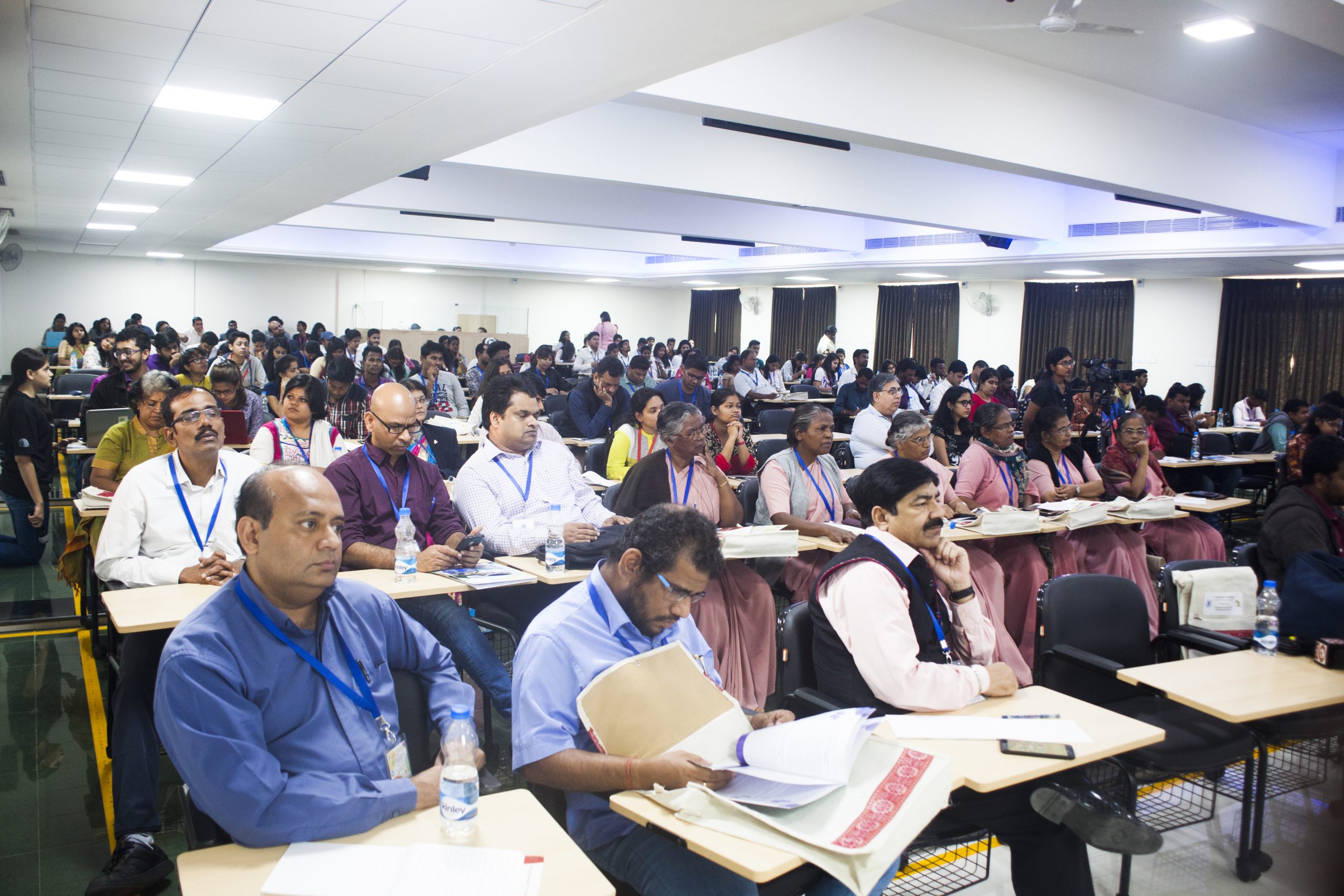Professional Lighting and Cinematography Workshop
The School of Communications, XIM University organized a day long workshop on Cinematography and Professional Lighting on 21 September 2019 in collaboration with Leksa Lighting Technologies Pvt Ltd., Mangalore. The resource persons for the workshop were, Mr. Ronald D’Souza, CEO, Leksa Lighting, Mr. Royal Peter, Manager, Leksa Lighting and Mr. Sudesh Kotian, a well-known cinematographer from Mumbai.
Fr. Alwyn Rodrigues SJ, Member of School of Communications CAS, introduced and welcomed the resource persons. Fr. Donald D’Silva SJ, Academic Dean, School of Communications addressed the participants and highlighted the need to learn the nuances of lighting to become better communicators and story tellers. Student representatives presented the saplings to the resource persons as a gesture of welcome.
Mr. Ronald, provided basic theoretical knowledge to students on different types of light sources and helped in understanding light from scientific point of view. He also discussed various types of lights starting from Natural light to Human made light. He pointed out that knowing how to use ambient light and technical light in the industry to be a good communicator is important today.
Mr. Royal Peter explained different types of lights used by the media industry today. Highlighting the need to use LED lights to support nature’s cause.
Mr. Sudesh Kotian, a renowned cinematographer who has his name associated with various television shows taught the participants, various views of capturing important moments and movements through video cameras. Students got a broad view on how the Film and TV industry operates and a need to maintain work ethics while working in the industry other than all the technicalities we learn. He taught the students, how to understand light in different situations, to create mood, narrate a story, make things look realistic etc. He said, a camera person becomes the eye for the director. It was an informative and exciting sessions for the participants who got both theoretical and hands on experience of using lights and understanding camera.
The resource persons distributed certificates to all the participants at the end of the workshop. Academic Dean of School of Communications felicitated the resource persons by giving a gift as a token of appreciation and love. Fr. Alwyn proposed the vote of thanks.
Immersion course
Two days immersion course on Social Norms and Media was organized for the third-year students of School of Communications on 5-6 September 2019 at XIM University. The immersion course was conducted as part of UNICEF’s project on helping students to understand social norms. The resource persons for the immersion course were, Fr. Donald D’Silva S.J., the Dean – School of Communications, Dr. Lopamudra Tripathy, Communication for Development Officer, UNICEF, Odisha, Prof. S. Peppin, Dean, School of Rural Management and Fr. Alwyn Rodrigues SJ, Faculty, School of Communications.
Students were exposed to the concepts and theories on Social Norms, how to use different tools and methods for measuring Social Norms, Identify and appreciate the connect between Media and Social Norms and how to appreciate the role of Social Norms in Behavioral Change Communication. Students were given group tasks on traditional, social media and social norms, and personal learning paper to know more on social norms.
Students were given hands on experience through films, role plays, and group activities, importance of understanding social norms and media today. Students also got an opportunity to produce a short film on social norms and media. Students presented their ideas and understanding on social norms that affect them and the society which they are part of. Students were awarded with participation certificate by the UNICEF
Reputation Today Conclave – 2020
The School of Communications, XIM University hosted a PR Conclave titled, ‘Reputation Today’ on February 12, 2020. The Dean of School of Communications, Fr. Donald D Silva, SJ. extended a warm welcome to the esteemed speakers and the student participants from nine Universities and Colleges from the City of Bhubaneswar and Cuttack.
The Vice Chancellor, Dr. Fr. Antony R. Uvari, S.J., felicitated the guests. He further emphasized on the importance of higher education and media literacy. The Registrar, Fr. E. A. Augustine, S.J., shared his words of encouragement with the audience and guests, enlightening the participants on the importance of respect and reputation.
The Conclave was spearheaded by Mr Amith Prabhu, founder of Promise foundation and advisor to Reputation Today – a magazine for Public Relations and Corporate Communications Professionals. His associates, experts in the field from other organizations volunteered to come to XIM University and share their expertise to motivate budding and interested audience over 200 to benefit from a day long conclave. Mr. Prabhu gave an overall picture of PR and its relevance today, educating the audience on the pillars and the strategies of PR.
Ms. Madhavi Jha, Head of Communications at Cairn Oil & Gas, enlightened the audience on the true ‘Definition of Ethics’ and its use in communication. The Managing Director at Public Relations firm – Ruder Finn India, Mr Atul Sharma shared a brief history of PR in the third session. He stated that as consumers, we love to buy stories and magic where brands have become more about vision and mission than about selling products. He summarized beautifully the topic of ‘what does a career in Public Relations look like’.
In the post lunch session, Ms Minol Ajekar – Head of communications, CSR and Business Operations at Puravankara, speaking on the future of PR and Corporate Communications stressed that PR is heavily dependent on communication. She discussed the 5C strategies which are followed by the corporate world. Mr. Mitu Samar, Founder of Eminence a consultancy firm talked about the difference between perception and reality. She emphasized mostly on celebrity PR and the emerging PR trends of the present era.
Before saying good bye, a brief panel discussion was held where the audience were given the opportunity to clear their doubts and enhance their knowledge on the sector of Public Relations. All the speakers stayed back to answer the questions from the audience and also offered help in support of student community in mentoring them to make right career choice. The conclave concluded with a final statement from Amith Prabhu and vote of thanks by Fr Donald D’Silva, S.J., Dean of School of Communications.
In Defense Of:
To prepare the media practitioners of tomorrow and as part of the Online Journalism and Writing for Media courses, an open discussion forum In Defense Of was organized by School of Communications on January 13, 2020. The idea of the session was to ensure a platform for the budding journalists to discuss, debate, deliberate and constructively criticize opposing views.
Journalism, as is known, is society in conversation with itself – to explore, to question, to innovate and to pursue the highest ideals of the discipline is what School of Communications strives to train the young minds with. In a time when asking the right question is equivalent to making a statement, the students discussed diverse subjects ranging from the current economic slowdown, to the extra constitutional killings, to the Transgender Rights Bill to the most contested Citizenship Amendment Act.
The discussion put forth an incredible range of unique ideas in the field of civil rights, constitutional laws, government policies, right to education and more. Through the informative and vibrant deliberations, the students brought in fresh perspectives to the socially pertinent issues.
Writing for Media
By Mr Sambit Pal
08.08.2018
A workshop was conducted by Mr. Sambit Pal today for the 1st year mass communication students. The objective of this initiative was to harness the writing skills of students and to give them an opportunity to learn from the current luminaries of this fast evolving and ever changing industry.
Mr. Sambit Pal has studied international journalism at Cardiff University has worked with the times now group and is currently the assistant editor at ABP Digital. His work credentials evidently show how much can a student learn from him. The workshop started at 9:30 AM and went on till 4 PM. Though the sessions were very long but they were also very interesting and productive at the same time. In the first session he discussed the basics of journalism emphasizing on the modest ‘ethics’ one must keep in mind while pursuing ones career as a journalist. The second session was about understanding the audience. Mr. Sambit beautifully explained the importance of audience catering and how our content should always be relatable and relevant to the audience. He spoke about how our content should always be unbiased, truthful and precise. He told the students how essential it was to be able to serve the needs of the audience and do your job of reporting precise and accurate news. To give us a better grasp of audience catering he did an interesting activity, he gave us a small news article and asked us to come up with headlines for that which would draw the readers attention. The following session was on writing for tv Mr. Sambit focused on teaching us that what are the basic guidelines that one should keep in mind while writing for television. He told the students that their articles should be conversational, active and it should be in present tense and the sentences should be direct while writing for television. He showed the students videos from his Youtube channel where he was reporting news from different parts of the country. He asked the students to notice how his sentences were direct, in present tense and active. After showing us some videos he again did an activity in class to instill better understanding of the subject. He divided the class into three groups and asked each group to present a piece of news as a package focusing on the anchor intro. He personally shot everygroup and once each of the group had presented he did a detailed evaluation of the clips discussing what went wrong or what could have been improved. This activity helped us realize our mistakes. His advices about how to improve ones oration is going to come in handy as we progress ahead on the path of becoming budding professionals. The last session was a practical session. We were given tasks to prepare a package for a news and also a multimedia article for the same. The class remained divided in three groups. He personally came and spoke to every group giving his inputs about how we could make our package better. We were given an hour to prepare both the items and after that we were asked to present our package and the multimedia article.
While we were sitting in groups and everyone was giving contributions for their groups I felt like I was in an editor meeting. Mr. Sambit not only gave us educational exposure but also created a newsroom atmosphere emphasizing on the philosophy of every ABP professional- ‘ no question is a stupid question’ he let our imagination run wild he allowed us to express ourselves freely. This workshop helped us tremendously to harness our writing skills more importantly Mr Pal was successful in giving us an overview of what writing for media was all about and how the chain of command, course of action and punctuality play an integral role in shaping ones career as a writer for media.
This workshop also embedded in us the importance of team work and also helped in strengthening our bond with our batch mates. Overall it was a very successful initiative taken by the School of Communications faculty it will surely help when we embark our journey as media professionals.
ADVERTISING PHOTOGRAPHY WORKSHOP REPORT
By Mr Arun Natarajan
School of Communications, XIM University conducted a two days’ workshop on Advertising Photography, for their undergraduate and post graduate students on 15th and 16th September 2018. The workshop was coordinated by Dr. V. Vijay Kumar, Academic Coordinator of School of Communications and it was conducted by Mr. Arun Natarajan.
Mr. Natarajan is a renowned advertising photographer from Chennai, an alumnus of the prestigious Loyola College Chennai. He did is BSc in Visual Communication and master’s in Journalism & Mass Communication. He specialised in product and lifestyle photography. He has worked with brands such as Vodafone, Uninor, Aircel, AirTel, MRF Tyres, Preethi Home Appliances, GRT Jewelers, The Hindu Newspaper, Times of India, Khazana Jewellery, Murugappa Group and Alliance Group. He has associated with Ogilvy & Mathers, Rediffusion, JWT, Lintas Lowie, Happy and Grey World-Wide advertising agencies.
The advertising photography workshop focused mainly on different types of product lighting and table top photography. The first day of the workshop started with the discussion on basic theories required for product photography, then the demonstration of different angles of lighting on a live subject was done. Later, Mr. Natarajan showcased his work to the students and narrated the complexities of it.
The second day was focused on letting the students take charge. The students brought various objects as requested by Mr. Natarajan. These objects ranged from toy cars and bikes, jewellery, lamps and many other decorative items. Mr. Natarajan himself also contributed to this collection by bringing his own props. He started by photographing a leaf to show the students the importance of detail. He then proceeded to photograph jewellery where the set up was constructed with the objects given by the students. Along with Mr. Natarajan clicking pictures, students have also carried their own cameras and equipment’s to photograph their perspective of the product and objects. He then proceeded to photograph other objects including toys, pomegranates, grapes, statues and more. He even showed the students photo editing techniques to help enhance their photographs. Mr. Natarajan then displayed some more of his work.
Finally, the session concluded with an interactive question-answer session amongst him and the students where students asked him about the integrities of photography. Students were then asked to share their experiences and learning from the workshop. Lastly, the students were divided into groups of three and given photography assignment. The workshop concluded by facilitating Mr. Natarajan with token of appreciation. Dr. V. Vijay Kumar, the academic coordinator of School of Communications presented gifts on behalf of School of Communications.
Fake News Verification Workshop A Google News Initiative
The School of Communications, XIM University conducted a workshop on November 24, 2018 in collaboration with Google News Initiative. The workshop witnessed an active participation of students and faculty members.
The workshop was held with focus being the rise of fake news circulation in different media platforms. Google News Initiative is aimed to bring the practitioners and the learners under one roof and put forth their perspectives with regards to current scenario of media communication. That apart, it also stresses on identification of fake news to help journalism thrive in the digital age. There are several fake news websites online from parodies to government propaganda sites and others which aim at creating chaos amongst its readers. The internet has enabled the sharing of knowledge in various ways. Currently, it is playing a significant role in spreading misinformation and disinformation.
Mr. Sambit Pal, Assistant Editor of ABP Digital headed the workshop which consisted of three major sessions – how to identify fake photos, how to identify fake videos and how to combat fake news. According toMr. Pal, journalism schools are doing an important work by moulding the future of media and training the next generation media professionals. However, with the intervention of digital world and overload of information in the newsrooms, classroom teaching may not be enough. Therefore, to serve this community better, Google News Initiative mobilises the thinking process and enhances the necessary skills required to succeed in newsrooms.
In each session the participants were given a hands-on training and were equipped with tools and strategies to identify and debunk fake news. To verify fake photographs, simple techniques such reverse image search, Rev eye, Tin eye, cropping image, time filter and Google translate are helpful. To check a certain piece of information the right search engine must be chosen and strong observational skill is necessary. Websites like Boom, Altnews, Internews and Data leads are working towards debunking fake news. To cross check the credibility of videos tools like YouTube Data Viewer, watch frame by frame are helpful. The other aspects like buildings, insignia, number plate, clothing, weather, signage must be taken into account. For social media platforms like Facebook and Twitter – People find Thor, Intel Techniques and foller.me, Twopcharts are used respectively. Checking website address, visual clues, by lines, hyperlinks, consistency of content and description also add up to the verification process. Apart from this, good old fashion journalism is always the best method for cross-verification.
With the rise of social media platforms , it becomes increasingly important to verify the online content critically to combat the challenges of fake information.
BARC India Workshop
What India watches- the need for effective television viewership measurement
Date: December 8, 2018
The Broadcast Audience Research Council of India (BARC), the prestigious sole licensed body to quantify audience measurement in India conducted a workshop at School of Communications, XIM University with two of its representatives- Mr. Shantanu Sen and Mr. Prashant Nair. The objective of this workshop was to inform media students about what BARC is and what they do. To educate the budding media professionals on the importance of data and how it plays an important role in the media industry and to find young minds to aid them in research collaborations. Mr. Sen started the session by giving a brief introduction for BARC which he described as a youthful organisation that still functions in the ‘start-up’ mentality.
The television industry in India is ever-growing even though many believe it to be dying due to the digital age. Statistics however, showed that 93% of the Indian population still consume television. How sample surveys are conducted, how are the households chosen for ‘panel’ installation and why the size of the sample is not directly related to the results were explained to the students. The entire process of choosing the sample, receiving the data and finding the final viewership data was part of the discussion.
While discussing the NCCS – New Consumer Classification System, it was explained as to on what basis the audience is divided into various demographics such as gender, age, location, urban or rural etc. The two important metrics to measure viewership are time and reach. The discussion was then carried forward by Mr. Prashant Nair. He stressed on the instability of this field. He believed that “entertainment will always sell and hence it is very important to quantify it”.
He then introduced the students to BIO News which was a new method of studying data created by BARC. It involved the smart visualisation of data, ensured efficiency of manpower and 90% reduction in the time taken by a data analyst to put together a report. Common terms which are used in this field included- target audience, reach, coverage, rating % or TRP, GRP, and ATS or average time spent. He further explained the concept of minute to minute viewership and how it helps study who is switching channels at what time and how this data helps the organisation come up with insights regarding viewership. He iterated that only having data is not enough, rather the more important part is the insights that we gain from this data.
Finally, he introduced the software BARC India Media Workstation where the data is collected, put together to be studied. He asked students for channels and shows with other details such as time period, which region they wanted to study and on what basis the viewers should be divided. Students were then showed how the data is compiled to formulate the results and deduce insights. Popular shows and programmes such as Naagin 3 , Big Boss 12, El Classico and India-Pakistan cricket match were quoted by the students.
While addressing questions about, transparency and ‘robustness’ of the data, it was explained that BARC is a unique joint venture, which is controlled by three parties- Agencies, Advertisers and IBF (Indian Broadcasting Foundation). Due to their joint control, no one party can control all decisions and this helps them remain unbiased and transparent. The final step taken by BARC to maintain the integrity of the data they produce is their Disciplinary Council which checks and ensures there is no data tampering to compromise their work.
Script to Screen
Filmmaking workshop
National award winner and renowned screenwriter/filmmaker, Mr Vinay Shukla conducted a daylong workshop with the students of School of Communications on 2nd February 2019. During the course of the workshop, Mr. Shukla engaged students in an interactive session and referred films like Godmother, Mirch and classics like Hum Panch, and Mother India. The focus was more on the nuances of scriptwriting and he shared the fact that script is the heart and soul of any good film. Mr. Shukla explained how a script travels from paper to screen. He also touched upon society’s reaction to the film text especially on the sensitive issues like sex, religion and politics etc.
Crisis Communication & Reputation Management
February 15, 2019
Expert: Ms. Lorraine Martin, Head of Corporate Communications, Ogilvy & Mather India, Mumbai
As an extension of the Advertising & Public Relations course, a daylong session with Ms. Lorraine Martin was organized on February 16 with the under-graduate and post-graduate students of School of Communications. Ms. Martin, a corporate communication expert from one of the world’s leading communication networks Ogivy & Mather specializes in the domain of crisis communication and reputation management.
The session represented an analysis and guide to handle crisis both locally and globally. With the advent of social media, how the fabric of crisis management has evolved over the past few years and how the ‘spiral’ effect of the social media on such instances can be curbed were few of the several parts of the threadbare discussion.
The students were categorized with groups and were made to work on real instances of corporate crisis case studies. Containing the crisis, ways of minimizing the media attention, tactfully handling and eventually utilizing ‘the press’ to one’s favour were some of the strategies learnt. The session was a perfect blend of theoretical knowledge and practical execution of the same.

